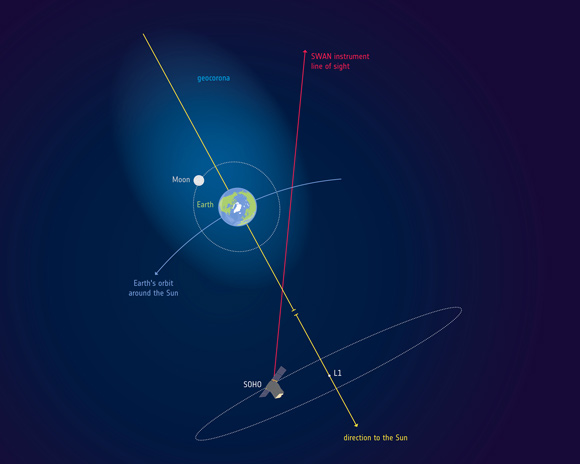Recent observations from the NASA/ESA Solar and Heliospheric Observatory (SOHO) show that the Earth’s hydrogen envelope reaches up to 391,500 miles (630,000 km) away, or 50 times the diameter of our planet.
Where our atmosphere merges into outer space, there is a cloud of hydrogen atoms called the geocorona.
“The first telescope on the Moon, placed by Apollo 16 astronauts in 1972, captured an evocative image of the geocorona surrounding Earth and glowing brightly in ultraviolet (UV) light,” said Dr. Jean-Loup Bertaux, a researcher at the Université Versailles Saint-Quentin in Guyancourt, France.
“At that time, the astronauts on the lunar surface did not know that they were actually embedded in the outskirts of the geocorona.”
The Solar Wind ANisotropies (SWAN) instrument on board SOHO used its sensitive sensors to trace the hydrogen signature and precisely detect how far the very outskirts of the geocorona are.
“The Sun interacts with hydrogen atoms through a particular wavelength of UV light called Lyman-alpha, which the atoms can both absorb and emit,” Dr. Bertaux and colleagues explained.
“Since this type of light is absorbed by Earth’s atmosphere, it can only be observed from space.”
“Thanks to its hydrogen absorption cell, the SWAN instrument could selectively measure the Lyman-alpha light from the geocorona and discard hydrogen atoms further out in interplanetary space.”
The SWAN observations revealed that sunlight compresses hydrogen atoms in the geocorona on Earth’s dayside, and also produces a region of enhanced density on the night side.
The denser dayside region of hydrogen is still rather sparse, with just 70 atoms per cm3 at 37,300 miles (60,000 km) above Earth’s surface, and about 0.2 atoms at the Moon’s distance.
“On Earth we would call it vacuum, so this extra source of hydrogen is not significant enough to facilitate space exploration,” said Dr. Igor Baliukin, from the Space Research Institute.
“There is also UV radiation associated to the geocorona, as the hydrogen atoms scatter sunlight in all directions, but the impact on astronauts in lunar orbit would be negligible compared to the main source of radiation — the Sun,” Dr. Bertaux said.
“On the down side, the Earth’s geocorona could interfere with future astronomical observations performed in the vicinity of the Moon.”
“Space telescopes observing the sky in UV wavelengths to study the chemical composition of stars and galaxies would need to take this into account.”
The findings were published in the Journal of Geophysical Research: Space Physics.
_____
I.I. Baliukin et al. SWAN/SOHO Lyman-α mapping: the Hydrogen Geocorona Extends Well beyond the Moon. Journal of Geophysical Research: Space Physics, published online February 15, 2019; doi: 10.1029/2018JA026136








